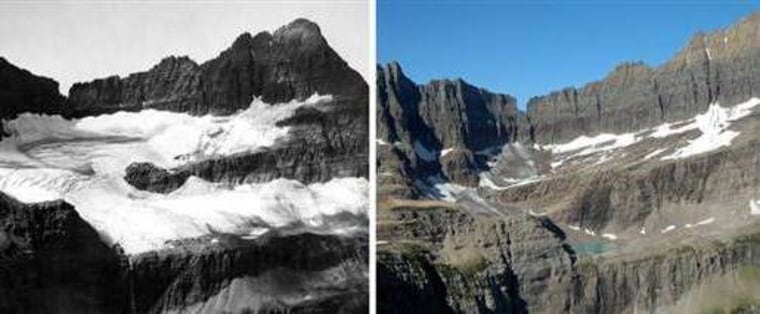Glacier National Park has lost two more of its namesake moving icefields to climate change, which is shrinking the rivers of ice until they grind to a halt, a government researcher said Wednesday.
Warmer temperatures have reduced the number of named glaciers in the northwestern Montana park to 25, said Dan Fagre said, an ecologist with the U.S. Geological Survey. He warned many of the rest of the glaciers may be gone by the end of the decade.
"It's continual," Fagre said. "When we're measuring glacier margins, by the time we go home the glacier is already smaller than what we've measured."
The meltoff shows the climate is changing, but does not show exactly what is causing temperatures to go up, Fagre said.
The park's glaciers have been slowly melting away since about 1850, when the centuries-long Little Ice Age ended. They once numbered as many as 150, and 37 of those glaciers eventually were named.
A glacier needs to be 25 acres to qualify for the title. The two that no longer classify were named the Shepard Glacier and the Miche Wabun Glacier.
If a glacier shrinks any smaller, it does not always stop moving right away. A smaller mass of ice on a steep slope would still continue to grind its way through the Rocky Mountains.
Fagre led a team that updated a 2005 USGS review of glaciers in the park. Back then, 10 glaciers had been found to have disappeared in recent decades.
Local warming cited
The USGS work was mentioned in a report released Wednesday by two environmental groups, the Rocky Mountain Climate Organization and the Natural Resources Defense Council.
Their report cited data from a weather station inside Glacier National Park that shows the average temperature for the last decade there was 2 degrees Fahrenheit hotter than the station's 1950-1979 average.
"That is exactly double the average global temperature increase of 1 degree F in the past decade, again compared to a 1950-1979 baseline," the groups stated.
Fagre's team estimates that in 1850 some 150 glaciers were in the boundaries of today's park. A 2003 study predicted that all remaining park glaciers would vanish by 2030, but the team now states that "their disappearance may occur even sooner, as many of the glaciers have recently retreated faster than their predicted rates."
Fagre said a handful of the park's largest glaciers could survive past 2020 or even 2030, but by that point the ecosystem would already be irreversibly altered.
Fagre said geological evidence points to the continual presence of glaciers in the area since at least 5000 B.C.
"They've been on this landscape continually for 7,000 years, and we're looking at them disappear in a couple of decades," he said.
Global trend
In alpine regions around the world, glacier melting has accelerated in recent decades as temperatures increased. Most scientists tie that warming directly to higher atmospheric concentrations of greenhouse gases such as carbon dioxide.
Some glaciers, such as in the Himalayas, could hold out for centuries in a warmer world. But more than 90 percent of glaciers worldwide are in retreat, with major losses already seen across much of Alaska, the Alps, the Andes and numerous other ranges, according to researchers in the United States and Europe.
In some areas of the Alps, ski resorts set atop glaciers have taken drastic measures to stave off the decline, such as draping glaciers in plastic sheeting to keep them cooler.
It could prove a losing battle: Scientists working for the United Nations say the last period of widespread glacial growth was more than three decades ago, lasting only for a few years.
Since about 1850, when the Little Ice Age ended, the trend has been steadily downward.
